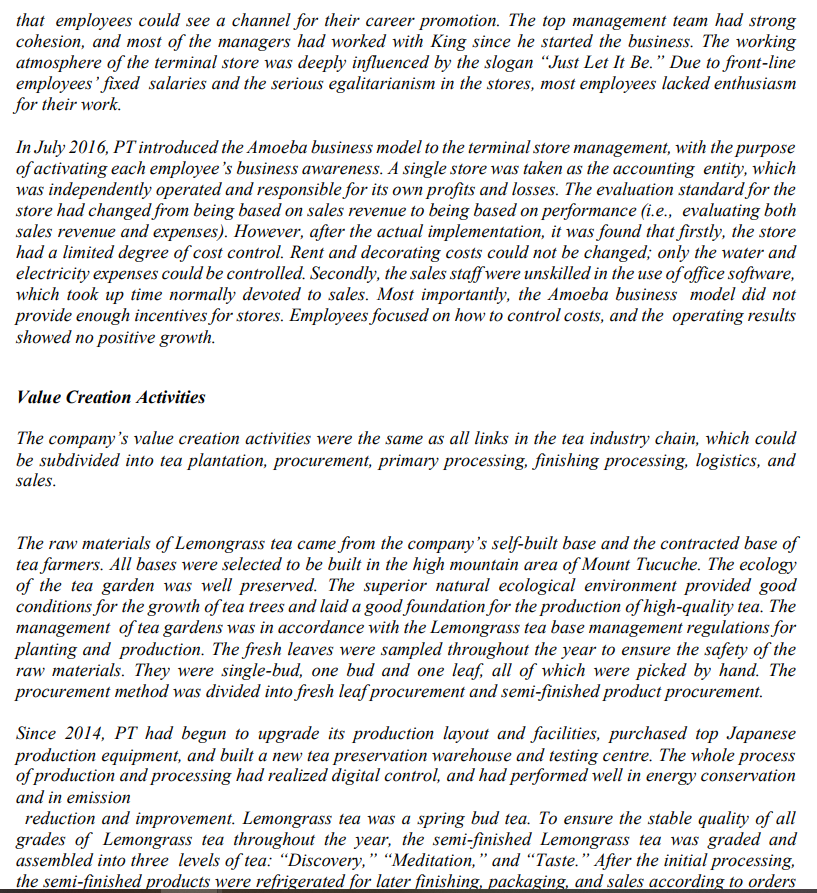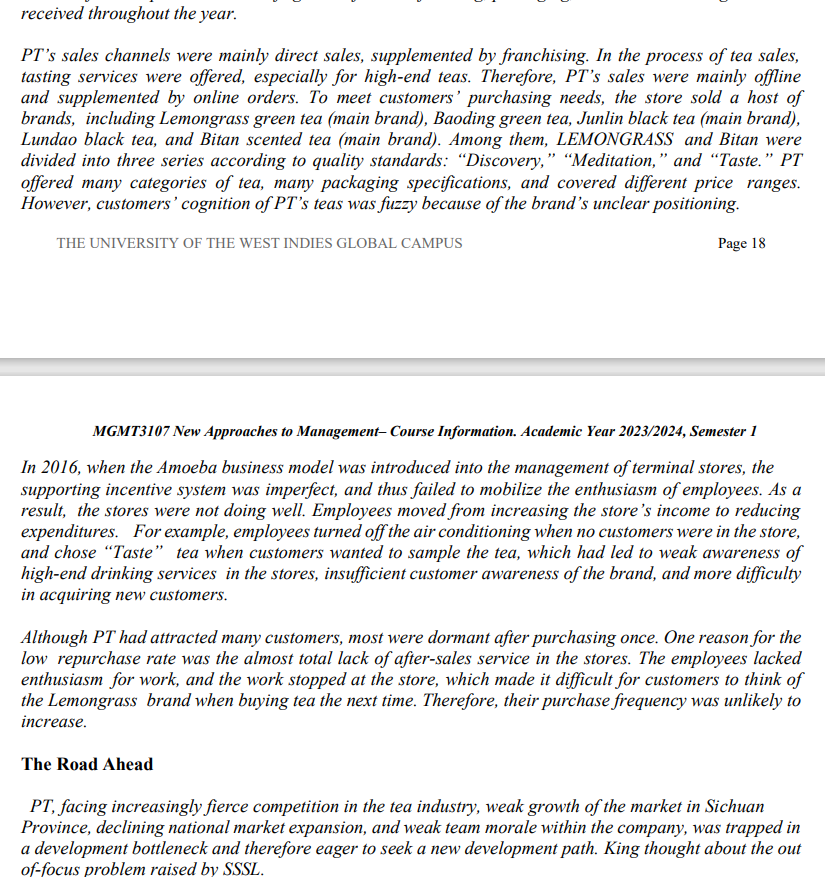The case study is based on an article about Pataka Tea Co., Ltd. (PT) - Reassessing the External Environment. Other parts of the case study were already posted with the same qustions Assignment Questions As of May 2018, what challenges had PT faced in recent years? Assess the factors in the internal and external environment that led to those challenges? Analyze the industry competition conditions that PT faced. Identify the key external factors that affected PT’s strategic decision. Develop a SWOT Analysis for PT to help King develop his strategy. Indicate how each of elements from the four (4)components from your SWOT, can be used to enhance PT’s competitive advantage. Each component of your SWO must have at least three (3) elements If you were Phillip King, chairman of PT, what recommendations – at least four (4), would you make to improve company performance and address the challenges you outlined in question 1. Provide clear justifications for your reasons.
The case study is based on an article about Pataka Tea Co., Ltd. (PT) - Reassessing the External Environment. Other parts of the case study were already posted with the same qustions Assignment Questions As of May 2018, what challenges had PT faced in recent years? Assess the factors in the internal and external environment that led to those challenges? Analyze the industry competition conditions that PT faced. Identify the key external factors that affected PT’s strategic decision. Develop a SWOT Analysis for PT to help King develop his strategy. Indicate how each of elements from the four (4)components from your SWOT, can be used to enhance PT’s competitive advantage. Each component of your SWO must have at least three (3) elements If you were Phillip King, chairman of PT, what recommendations – at least four (4), would you make to improve company performance and address the challenges you outlined in question 1. Provide clear justifications for your reasons.
Management, Loose-Leaf Version
13th Edition
ISBN:9781305969308
Author:Richard L. Daft
Publisher:Richard L. Daft
Chapter2: The Evolution Of Management Thinking
Section: Chapter Questions
Problem 10EE
Related questions
Question
The case study is based on an article about Pataka Tea Co., Ltd. (PT) - Reassessing the External Environment.
Other parts of the case study were already posted with the same qustions
Assignment Questions
- As of May 2018, what challenges had PT faced in recent years? Assess the factors in the internal and external environment that led to those challenges?
- Analyze the industry competition conditions that PT faced. Identify the key external factors that affected PT’s strategic decision.
- Develop a SWOT Analysis for PT to help King develop his strategy. Indicate how each of elements from the four (4)components from your SWOT, can be used to enhance PT’s competitive advantage. Each component of your SWO must have at least three (3) elements
- If you were Phillip King, chairman of PT, what recommendations – at least four (4), would you make to improve company performance and address the challenges you outlined in question 1. Provide clear justifications for your reasons.

Transcribed Image Text:that employees could see a channel for their career promotion. The top management team had strong
cohesion, and most of the managers had worked with King since he started the business. The working
atmosphere of the terminal store was deeply influenced by the slogan "Just Let It Be." Due to front-line
employees' fixed salaries and the serious egalitarianism in the stores, most employees lacked enthusiasm
for their work.
In July 2016, PT introduced the Amoeba business model to the terminal store management, with the purpose
of activating each employee's business awareness. A single store was taken as the accounting entity, which
was independently operated and responsible for its own profits and losses. The evaluation standard for the
store had changed from being based on sales revenue to being based on performance (i.e., evaluating both
sales revenue and expenses). However, after the actual implementation, it was found that firstly, the store
had a limited degree of cost control. Rent and decorating costs could not be changed; only the water and
electricity expenses could be controlled. Secondly, the sales staff were unskilled in the use of office software,
which took up time normally devoted to sales. Most importantly, the Amoeba business model did not
provide enough incentives for stores. Employees focused on how to control costs, and the operating results
showed no positive growth.
Value Creation Activities
The company's value creation activities were the same as all links in the tea industry chain, which could
be subdivided into tea plantation, procurement, primary processing, finishing processing, logistics, and
sales.
The raw materials of Lemongrass tea came from the company's self-built base and the contracted base of
tea farmers. All bases were selected to be built in the high mountain area of Mount Tucuche. The ecology
of the tea garden was well preserved. The superior natural ecological environment provided good
conditions for the growth of tea trees and laid a good foundation for the production of high-quality tea. The
management of tea gardens was in accordance with the Lemongrass tea base management regulations for
planting and production. The fresh leaves were sampled throughout the year to ensure the safety of the
raw materials. They were single-bud, one bud and one leaf, all of which were picked by hand. The
procurement method was divided into fresh leaf procurement and semi-finished product procurement.
Since 2014, PT had begun to upgrade its production layout and facilities, purchased top Japanese
production equipment, and built a new tea preservation warehouse and testing centre. The whole process
of production and processing had realized digital control, and had performed well in energy conservation
and in emission
reduction and improvement. Lemongrass tea was a spring bud tea. To ensure the stable quality of all
grades of Lemongrass tea throughout the year, the semi-finished Lemongrass tea was graded and
assembled into three levels of tea: "Discovery," "Meditation," and "Taste." After the initial processing,
the semi-finished products were refrigerated for later finishing, packaging, and sales according to orders

Transcribed Image Text:received throughout the year.
PT's sales channels were mainly direct sales, supplemented by franchising. In the process of tea sales,
tasting services were offered, especially for high-end teas. Therefore, PT's sales were mainly offline
and supplemented by online orders. To meet customers' purchasing needs, the store sold a host of
brands, including Lemongrass green tea (main brand), Baoding green tea, Junlin black tea (main brand),
Lundao black tea, and Bitan scented tea (main brand). Among them, LEMONGRASS and Bitan were
divided into three series according to quality standards: "Discovery," "Meditation," and "Taste." PT
offered many categories of tea, many packaging specifications, and covered different price ranges.
However, customers' cognition of PT's teas was fuzzy because of the brand's unclear positioning.
THE UNIVERSITY OF THE WEST INDIES GLOBAL CAMPUS
Page 18
MGMT3107 New Approaches to Management-Course Information. Academic Year 2023/2024, Semester 1
In 2016, when the Amoeba business model was introduced into the management of terminal stores, the
supporting incentive system was imperfect, and thus failed to mobilize the enthusiasm of employees. As a
result, the stores were not doing well. Employees moved from increasing the store's income to reducing
expenditures. For example, employees turned off the air conditioning when no customers were in the store,
and chose "Taste" tea when customers wanted to sample the tea, which had led to weak awareness of
high-end drinking services in the stores, insufficient customer awareness of the brand, and more difficulty
in acquiring new customers.
Although PT had attracted many customers, most were dormant after purchasing once. One reason for the
low repurchase rate was the almost total lack of after-sales service in the stores. The employees lacked
enthusiasm for work, and the work stopped at the store, which made it difficult for customers to think of
the Lemongrass brand when buying tea the next time. Therefore, their purchase frequency was unlikely to
increase.
The Road Ahead
PT, facing increasingly fierce competition in the tea industry, weak growth of the market in Sichuan
Province, declining national market expansion, and weak team morale within the company, was trapped in
a development bottleneck and therefore eager to seek a new development path. King thought about the out
of-focus problem raised by SSSL.
Expert Solution
This question has been solved!
Explore an expertly crafted, step-by-step solution for a thorough understanding of key concepts.
Step by step
Solved in 3 steps

Follow-up Questions
Read through expert solutions to related follow-up questions below.
Follow-up Question
As of May 2018, what challenges had PT faced in recent years? Assess the factors in the internal and external environment that led to those challenges?
Solution
Recommended textbooks for you

Management, Loose-Leaf Version
Management
ISBN:
9781305969308
Author:
Richard L. Daft
Publisher:
South-Western College Pub

Management, Loose-Leaf Version
Management
ISBN:
9781305969308
Author:
Richard L. Daft
Publisher:
South-Western College Pub